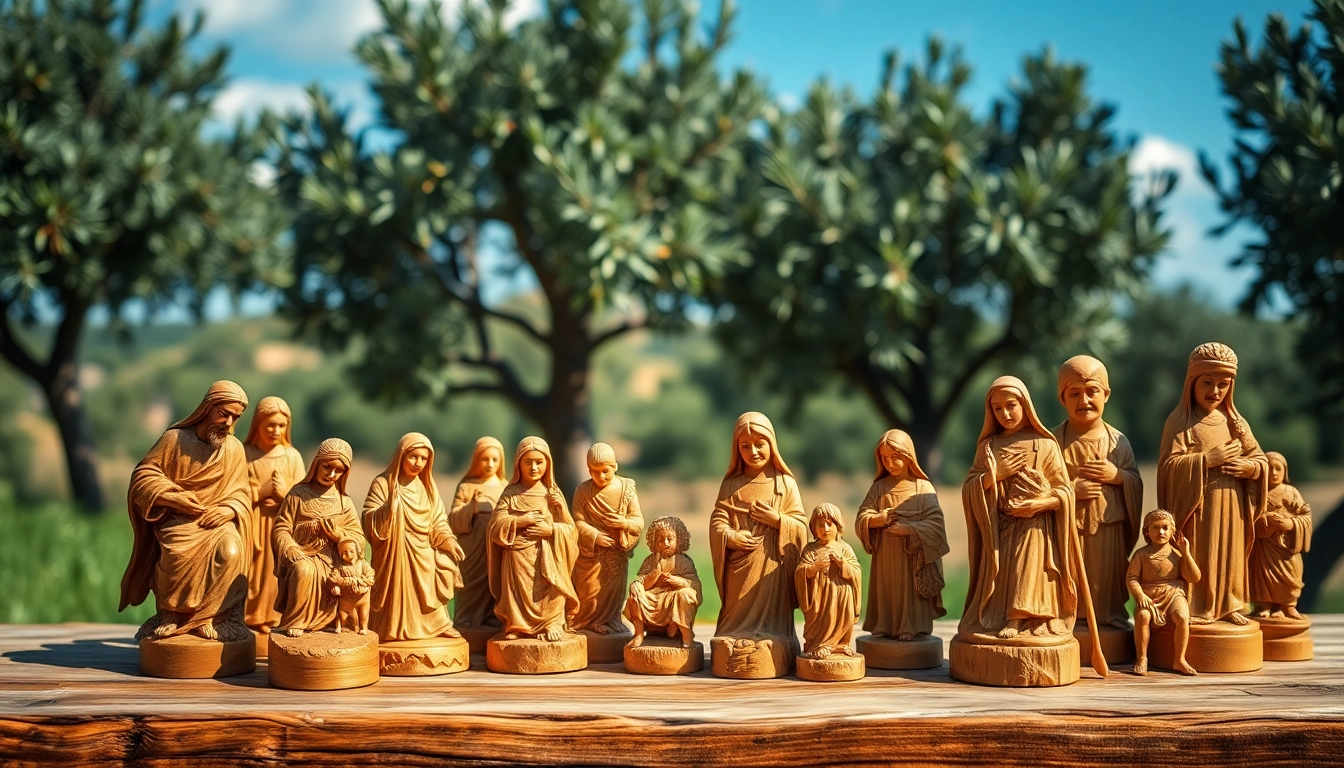Understanding Olive Wood Carvings
Olive wood carvings represent a unique blend of artistry and cultural significance, often serving as tangible connections to the rich history and traditions of the Holy Land. Olive wood carvings are crafted from the wood of ancient olive trees, a symbol of peace and resilience, adding to their appeal as cherished decorative items and heirlooms. This article delves deep into the nuances of olive wood carvings, exploring their significance, historical background, artistic techniques, popular varieties, purchasing options, gift potential, and cultural impacts.
The Significance of Olive Wood in Art
Olive wood is more than just a material; it carries profound cultural and historical roots, particularly in countries like Israel and Palestine where the olive tree is regarded as sacred. The durability and distinctive grain of olive wood make it ideal for carving, enabling artisans to produce finely detailed pieces. Beyond this, olive wood signifies peace and harmony, often representing the hope and endurance of its people through continuous struggles.
Historical Context of Carvings from the Holy Land
The tradition of olive wood carving in the Holy Land traces back centuries, deeply intertwined with the region’s religious and cultural narratives. Historically, olive wood figures were crafted for devotional purposes, including figures of saints and scenes from the Bible. Over time, these artistic expressions expanded to include a variety of decorative items and functional products, reflecting the evolving tastes and needs of both local and international markets.
Traditional Techniques Used by Artisans
Artisans employ a range of traditional techniques to create olive wood carvings. These methods often involve hand-carving, which ensures that each piece maintains its unique character. Tools traditionally used include chisels and knives, allowing for intricate designs and details. Moreover, many craftsmen pass down their skills through generations, preserving the historical crafting methods that define this art form. The craftsmanship process typically involves selecting high-quality pieces of olive wood, sketching designs, and meticulously carving the wood until the final sculpture emerges. This labor-intensive process showcases not just skill but deep-rooted respect for the material.
Popular Types of Olive Wood Carvings
Olive wood carvings come in various forms, each serving distinct purposes and appealing to different audiences. Below are some of the most popular types:
Statues and Religious Figures
Many olive wood carvings are statues representing religious icons, saints, and biblical figures. For instance, renowned pieces depicting the Nativity scene or crucified Christ not only serve as decorations but also as focal points for religious contemplation. Carvings such as these are often found in homes and places of worship alike.
Decorative Items and Home Décor
In addition to religious symbols, artisans produce a wide range of decorative items sculpted from olive wood. These include bowls, utensils, and abstract pieces that add a touch of natural elegance to any home. The nuanced grain and rich hues of the wood contribute to its popularity in home décor, driving demand among both decorators and individual buyers.
Nativity Sets and Their Symbolism
Nativity sets carved from olive wood have been beloved for centuries, symbolizing not only the Christmas story but also the craftsmanship traditions of the Holy Land. These sets typically include detailed figures representing Jesus, Mary, Joseph, the shepherds, and the Wise Men, handcrafted to evoke the essence of the manger scene. The use of olive wood in nativity sets resonates with consumers looking for authentic representations of their faith.
Where to Buy Authentic Olive Wood Carvings
Finding genuine olive wood carvings requires knowing where to look. Below are key avenues for sourcing authentic pieces:
Online Marketplaces and Retailers
One of the most accessible ways to purchase olive wood carvings is through online marketplaces and specialty retailers. Websites dedicated to Holy Land crafts often feature a variety of items, from religious sculptures to everyday homewares. This online platform allows shoppers to compare styles and prices, while also reading reviews to ensure authenticity. Merchants who specialize in these crafts often provide information about the artisans behind the creations, further enhancing the purchasing experience.
Visiting Local Artisan Shops
For a truly immersive experience, visiting local artisan shops in regions known for olive wood carvings, especially those in Bethlehem and Jerusalem, can be rewarding. These storefronts often showcase a broader range of styles, and purchasing directly allows customers to interact with the artisans, gaining insights into their techniques and inspirations. Additionally, visiting local shops supports the communities that rely on this craft for their livelihoods.
Televised Auctions and Exhibitions
Televised auctions and art exhibitions can offer unique opportunities to acquire rare olive wood pieces. Specialty auctions dedicated to crafts and religious art can attract collectors and enthusiasts alike, presenting high-quality carvings that may not be available elsewhere. Attending exhibitions provides further chances to witness craftsmanship in action and network with other collectors and artisans.
Gift Ideas Featuring Olive Wood Carvings
Olive wood carvings also make fantastic gifts for various occasions. The significance of the material, combined with the artistry behind each piece, translates into meaningful presents. Here are some ideal gift ideas:
Personalized Gifts for Special Occasions
Personalization adds a heartfelt touch to gifts, particularly for significant occasions like weddings, anniversaries, or births. Customized olive wood carvings, whether engraved with names or special dates, can serve as lasting mementos and are often cherished as family heirlooms.
Choosing the Right Piece for Loved Ones
When selecting an olive wood carving for a loved one, consider their personal style and interests. For instance, a gorgeously crafted nativity set might resonate well with someone who deeply values their faith, whereas a decorative bowl could appeal more to an individual with a flair for interior design. Thoughtfulness in selection shows care and consideration, amplifying the gift’s emotional value.
Custom Carvings for Religious Events
For religious ceremonies, such as baptisms or confirmations, custom carvings can serve as meaningful gifts. These can take the form of symbols significant to the individual’s faith, enhancing the ceremony’s significance and providing a lasting reminder of the event.
The Cultural Impact of Olive Wood Carvings
The impact of olive wood carvings extends beyond mere consumer goods; they play a crucial role in cultural preservation and community support. Below, we explore these dimensions.
Promoting Local Artisans and Economies
Purchasing olive wood carvings directly supports local artisans and their families, helping to sustain traditional practices that may otherwise fade over time. This economic factor encourages communities to preserve their artistic heritage and provides livelihoods that depend on the sale of these handcrafted goods. As olive wood carving remains integrated into local cultures, its status as an art form becomes more secure.
Preserving Traditional Craftsmanship
As global production and mass manufacturing become increasingly prevalent, the tradition of olive wood carving stands as a testament to the value of craftsmanship. Initiatives that promote these artistic practices often include workshops and training sessions for younger generations, ensuring that the skills necessary for carving remain available. By fostering environments for artisans to practice their craft, communities can maintain the cultural narratives tied to olive wood art.
Connecting Across Cultures Through Art
Olive wood carvings have the power to transcend cultural and geographical boundaries. They often encapsulate stories and beliefs from the Holy Land, inviting owners to explore and appreciate teachings that may differ from their own. Through these artistic expressions, individuals can engage in dialogues that foster understanding and appreciation among diverse cultures. The beauty of olive wood naturally instigates conversations about faith and heritage, allowing for meaningful exchanges that resonate far beyond the original context.



